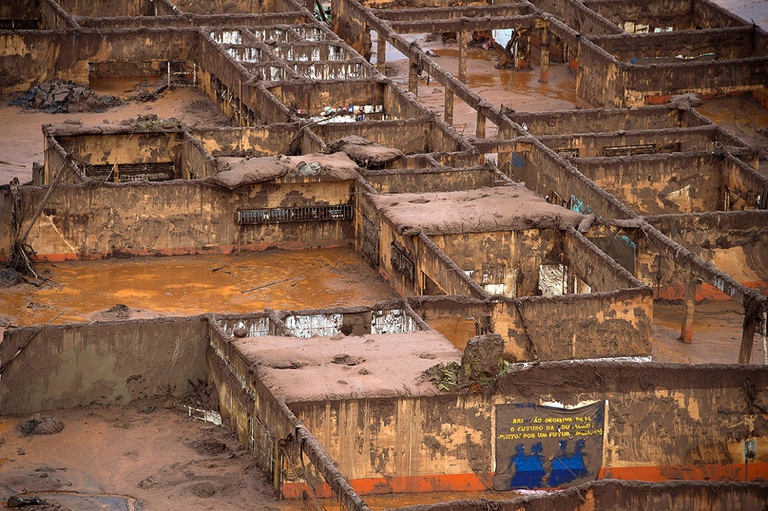
A group of experts in Tokyo suggested pouring radioactive water from Fukushima into the open sea. A marine biochemist explains the consequences of this absurd decision.
The dam burst of 5 November is one of the worst mining disasters in Brazil’s history, and could have irreparably contaminated the area.
11 people have died, 12 are missing, 500 are displaced, and incalculable environmental damages have been caused. These are the figures of the accident in which two dams collapsed in an iron mine owned by the mining society Samarco, south-eastern Brazil.
On 5 November, the village of Bento Rodrigues a Mariana, in the region of Minas Gerais, has been covered with mud, slime, and toxic waste and residuals, after two dams built to contain wastewater have collapsed.
Brazilian President Dilma Rousseff compared the accident to the disaster in the Gulf of Mexico, caused by the oil rig owned by the British Petroleum (BP).
Over 250,000 people currently do not have access to drinking water, whilst waterways are coloured in a disquieting orange.
The dam burst caused the spill of over 50 million cubic metres of mud and residual liquids of the mine, containing highly toxic substances such as mercury. The mining company Samarco agreed to pay 260 million dollars.
The company, co-owned by the mining giants Vale and BHP Billiton, has repeatedly denied the toxicity of mud and committed to carrying out all possible efforts to prioritize the needs of people affected.
“It’s already clear wildlife is being killed by this mud,” said Klemens Laschesfki, professor of geosciences at the Federal University of Minas Gerais. “To say the mud is not a health risk is overly simplistic.”
Brazilian authorities consider the sum not to be enough to cover the huge damages on the environment and people. “This is only a first instalment,” said state prosecutor Carlos Eduardo Ferreira Pinto.
The causes and the environmental consequences of the accident are still not clear. According to scientists, mud – which could contain chemicals used to reduce iron impurities – can alter waterways, reduce oxygen levels in water, and decrease fertility in agricultural lands.
This disaster is only the last in the area of Doce river, one of the most important connections between the state of Minas Gerais and the Atlantic Ocean. The area, crossing the thick rainforest, has always been strongly exploited, mainly for gold and iron, since the Portuguese colonisation.
Biologists now fear that toxic substances spilled into the river could also contaminate the coast. The mouth of the Doce river is a nesting place of sea turtles, which are threatened with extinction and are particularly sensitive to water chemical changes.
All animal species in the area, both aquatic and terrestrial, are dying by asphyxiation. In order to protect aquatic life the so called Operation Noah’s Ark has been launched, aimed to prevent fish species living in the river from extinction.
Siamo anche su WhatsApp. Segui il canale ufficiale LifeGate per restare aggiornata, aggiornato sulle ultime notizie e sulle nostre attività.
![]()
Quest'opera è distribuita con Licenza Creative Commons Attribuzione - Non commerciale - Non opere derivate 4.0 Internazionale.
A group of experts in Tokyo suggested pouring radioactive water from Fukushima into the open sea. A marine biochemist explains the consequences of this absurd decision.
The decline in grey and humpback whales in the Pacific and Atlantic Oceans has been traced to food shortages caused by rising ocean temperatures.
The United Nations has launched a major international alliance for ocean science, undertaking a mission close to all our hearts.
The cargo ship that ran aground off the coast of Mauritius on 25 July, causing incalculable damage, has split in two and its captain has been arrested.
The largest coral reef in the world is severely threatened by climate change, but researchers are developing strategies that could contribute to saving the Great Barrier Reef.
Seychelles have extended its marine protected area, which now covers over 400,000 square kilometres, an area larger than Germany.
Norwegian oil giant Equinor had pulled out of drilling for oil in the Great Australian Bight, one of the country’s most uncontaminated areas. A victory for activists and surfers who are now campaigning for the area to be protected forever.
30 per cent of the planet needs to be protected to stop precipitous species decline. The UN has set out its aims for the the COP15 on biodiversity scheduled for Kunming, China in October.
Ocean warming has risen to record highs over the last five years: just in 2019 the heat released into the world’s oceans was equivalent to that of 5-6 atomic bombs per second. The culprit, no doubt, is climate change.










